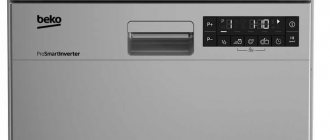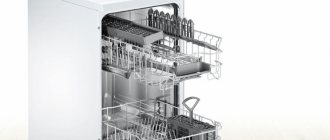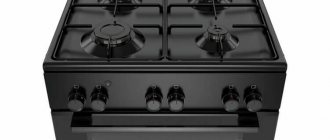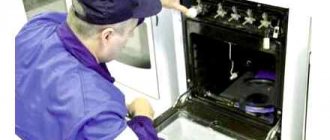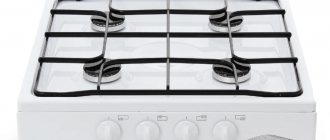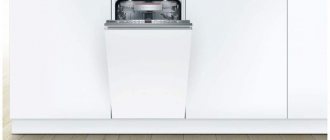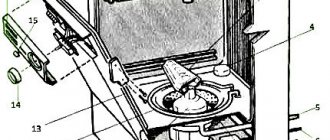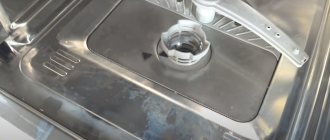Compact dishwashers are well suited for small kitchens. Branded models are expensive, so users are increasingly paying attention to devices made in China, for example Midea MFD45S100W. They are characterized by low cost and good functionality. Such dishwashers also have their own disadvantages, which must be taken into account when choosing a product.
Distinctive features
When buying a Midea dishwasher, you should take into account the advantages and features of the products, such as:
- most models are equipped with dish baskets with the ability to adjust the height, which is very convenient and will allow you to clean not only dishes, but also tall pots, vases and other bulky items;
- Each machine comes with detailed instructions;
- premium segment machines have glass holders, a separate compartment for cutlery, internal lighting and energy efficiency class A++;
- Compact Midea appliances are made of quality materials.
About
Rules for loading dishes
Before the first start, it is important to understand how to properly load dishes into the dishwasher. It has its own rules and restrictions.
The space inside most dishwashers is divided into three zones.
- The lower basket contains bulky, large-sized dishes that are difficult to wash: pots, pans, deep bowls. The lids are also placed here: they are inserted into the frame of the basket along the edges so as not to interfere with the rotating parts.
- The upper basket is designed for smaller and lighter items: plates, saucers, cups, glasses. If space allows, you can put a not too dirty flat frying pan.
- Tray or separate basket for cutlery. Spoons, knives and forks are neatly arranged or laid out in compartments, avoiding clutter.
When placing dishes, you must follow several rules.
- Large pieces of food should be removed.
- Deep dishes, from cups to pans, are turned upside down. Otherwise, water will accumulate inside and drying will not be effective.
- All utensils must be held firmly in place so that the jet of water cannot dislodge or knock them over.
- Sharp knives should only be placed horizontally to avoid accidental injury. If the cutlery tray requires vertical placement, such blades are placed in the upper basket.
- Fragile thin-walled objects should not come into contact with other dishes, and especially with each other.
- It is better to wash very small items (for example, glasses) by hand, as they may fall out of the basket.
- The contents of the baskets must not interfere with the rotation of the rocker arms.
- Do not load the dishwasher beyond the capacity specified in the instructions. Because of this, work will become less quality, and electricity consumption will increase.
There are also recommendations for unloading the machine.
- Start with the bottom basket. If you do the opposite, when manipulating the upper basket, drops will fall onto the dishes below.
- Do not remove glasses and other thin-walled dishes immediately after the end of the cycle, but give them time to cool: they are especially fragile while they are hot.
During the washing process, water and detergent do not always reach the dishes due to the limited geometry of water spray. Therefore, Midea has developed the latest InnoWash system, which is capable of solving complex problems even with incorrectly installed dishes. InnoWash allows one of the rocker arms to rotate not only around a common axis, but also to engage its own axis when rotating a special gear installed in the center of the system. This ensures excellent dishwashing performance.
Dishwasher Midea MFD 60S900 X with InnoWash
Types of dishwashers
Midea dishwashers are divided into 3 types:
- built- in This technique is easy to use and compact; it is suitable for small kitchens, when every free centimeter matters. In terms of technical characteristics and quality, such units are not inferior to full-size models. The noise level during operation varies from 45 to 49 dB;
- compact dishwashers . The most profitable cars in terms of size. The dimensions allow you to install the equipment on a tabletop or on any other surface where there is a possibility of connecting communications. The prices for such cars are an order of magnitude lower than for full-size ones. The only drawback is the small capacity, up to 8 full sets of dishes;
- full size It is advisable to install such dishwashers in kitchens with a large area, where there is no need to save space. The advantage of the machines is extended functionality, many useful additional options, good box capacity up to 16 sets of dishes. The disadvantage of this technology is its high cost and large size.
About
What products are needed for dishwashers?
Before starting the dishwasher for the first time, special salt is poured into the reservoir, which restores the function of the ion exchanger to soften the water. It removes substances from tap water that can damage equipment. The more impurities in the water, the more salt is required, so its consumption is regulated by a hardness switch. You can find out the degree of water hardness from your local utility service.
Next, you need to figure out how to use dishwasher detergent. It is placed in an appropriate tank immediately before launch. Never use soap, washing powder or hand washing liquids - only products specifically designed for dishwashers. According to the release form, they come in three types: tablets, gels and powder.
It is important to add rinse aid; its dosage level is set depending on the type of detergent. rinse aid If you add it when washing, there will be no stains or streaks left on the dishes from drops of water. In addition, drying is accelerated because water drains from surfaces faster. The rinse aid has its own reservoir on the door, next to the detergent compartment.
Advantages of devices
Among the advantages of the Midea technique are::
- long service life;
- manufacturer's warranty for each product for 12-24 months;
- a wide range of products to suit every taste and budget;
- ergonomic screen, convenient and simple control panel;
- internal lighting, thanks to which you can always control the process;
- Only high-quality materials are used in the manufacture of equipment. Before being supplied to the world market, each dishwasher undergoes a series of tests;
- most models have energy efficiency class A-A++;
- The models are equipped with a child lock and protection against water overflow and leaks, which will make work safe and increase the service life of the equipment.
About
Dishwasher Care
Servicing a dishwasher does not take much time; you just need to follow a few simple rules.
- Ventilate the chamber after work, leaving the door slightly open - this will prevent the appearance of unpleasant odors.
- For external cleaning, use high-quality products for polishing devices without an abrasive effect. In this aspect, there is a difference between how to use a built-in dishwasher and a free-standing one. Built-in appliances are faced with panels in the same style as the furniture. The rules for caring for them should be obtained from the manufacturer of the kitchen set.
- The rubber seals become clogged with food debris that must be removed regularly with a soft sponge.
Follow these instructions, and the operation of the device will be as productive as possible. The machine will work for a long time, and the quality of washing will remain impeccable throughout its service life.
How to choose and what to pay attention to?
Before purchasing a dishwasher, you need to consider the following parameters:
- capacity of the box for dishes, dimensions of the model . The machine’s performance, service life and ease of use depend on these indicators. The capacity of the dishwasher shows how many full sets of dishes the unit can clean in 1 operating cycle. Midea dishwashers come in 3 types - narrow, with a capacity of 3 to 7 sets of dishes, compact (medium), which can clean 8-11 sets per cycle, and full-size, which can easily handle 10-16 sets of dishes, regardless of the degree of contamination;
- resource consumption per cycle . Midea dishwashers have a high energy efficiency value, corresponding to values from A to A++. If you want to save water resources as much as possible, pay attention to full-size models;
- noise level . An important parameter when choosing a dishwasher, which sometimes becomes decisive. When the machine is operating, the noise level is 44-49 dB.
About
What dishes should not be washed in the dishwasher?
Most dishes tolerate machine washing well, but there are exceptions.
- Non-heat-resistant cookware made entirely or partially from plastic, synthetic fibers, etc.
- Utensils made of wood entirely or partially: cutting boards, wooden spoons, etc.
- Products made of tin, copper, and corrosion-prone steel grades. Aluminum and silver are more durable, but frequent machine washing can cause these metals to tarnish.
- Any crystal.
- Dishes with glazed designs: they gradually fade and wear off.
- Plates or cups that have previously been glued together: Hot steam can melt the glue and break the joint.
- Many people are concerned about whether pans can be washed in the dishwasher. It is possible, but not all, the answer depends on the material of the kitchen utensils. Cast iron's protective oxide layer is damaged and corrosion begins. Teflon dishwashers are even more dangerous. But machine washing will not harm frying pans with titanium and ceramic coatings.
If the packaging of a plastic container explicitly states that it cannot be used in the dishwasher, then it is better not to risk it, as some types of plastic can melt under intense exposure to hot water.
If in doubt, look for the corresponding marking on the bottom of the dish (a pictogram in the form of two plates or a plate and a glass under running water). If the same symbol is crossed out, only hand washing is allowed.
Conclusions and best offers on the market
Even among the three competing models we have presented, there are options that can “compete” with the device discussed in the article. Thanks to the abundance of trade offers, you can buy a machine on terms that are more favorable to your own wallet. The following selection will help you study the price range:
The list of disadvantages is much shorter than the list of advantages, so the Midea dishwasher with a width of 45 cm, model MFD45S100W, can confidently be classified as a budget, but quite functional unit. But we have yet to find out how trouble-free they are after several years of operation.
Are you looking for an inexpensive and high-quality dishwasher for your compact kitchen? Or do you have experience using a unit from Midea? Tell our readers about the specifics of operation and maintenance of such equipment. Share your personal experience and ask questions - the comment form is located below.
Features of PMM 45 cm wide
Dishwashers whose width is 45 cm are called narrow. They are 15 cm narrower than their full-size counterparts and hold 3–4 less sets of dishes. Narrow modifications hold 9–10 sets.
Features of PMM "Midea":
- Inno Wash system. Uses a special rocker with the same name. It rotates in two planes - through the use of a special gear. The rocker rotates 360 degrees, so water is effectively distributed throughout the chamber. The technology ensures perfect washing no matter where the dishes are placed.
- Minimum noise level. Low-noise devices operate with a noise level of 42–44 dB.
- Third basket Infinity. It contains small cutlery and utensils. The cleaning efficiency at the top is ensured by the third spray arm.
- Some models use Turbo Drying. It uses external air supply.
Washing programs and modes
The device is equipped with the following options and programs:
- accelerated wash cycle;
- delicate processing of glass and porcelain dishes;
- energy saving mode;
- delayed start up to 8 hours;
- standard program;
- use of 3 in 1 tablets;
- partial protection against leaks;
- standard cycle.
Advantages and disadvantages
According to user reviews, the dishwasher has the following advantages:
- economical consumption of detergent, achieved thanks to the slider dispenser;
- the presence of an additional rinse function that helps eliminate white deposits and refresh washed dishes;
- the presence of a delay start timer (the function is useful when installed in houses with a dual electricity tariff system);
- compact dimensions allowing you to install the machine in any convenient place or move it.
The disadvantages of the presented model include:
- lack of a program for cleaning the chamber from fat deposits;
- lack of digital display;
- the need to regularly clean the filter;
- small camera capacity.
How to use
Using a Midea dishwasher is easy. According to the instruction manual, the procedure for starting the device includes the following steps:
- Connection. The machine is connected to the water supply system by installing an adapter located in front of the hose leading to the mixer. To regulate the water supply, a ball valve is connected. The drain hose is connected to the sewer through a siphon fitting. When connecting the Midea MFD45S100W dishwasher, the instructions require using an electrical network with a power of at least 2.3 kW.
- Preparing for work. Using a funnel, 1.5 kg of salt is poured into a special compartment. Rinse aid is also added, which is gradually consumed by the device. When loading, pots and pans are placed on the lower levels, plates and cups on the upper levels.
- Launch. The selection of programs is carried out by pressing the buttons located on the control panel. Start the device by using the “Start” button. You can open the door and remove dishes only after the sound signal appears.
During operation of the device, you need to regularly add salt and rinse aid. A common problem with Chinese dishwashers and washing machines is frequent filter clogging. Repair involves disconnecting hoses, removing and cleaning filters. The parts are washed with water and returned to their place.
Specifications
The Midea dishwasher has the following technical characteristics:
- installation type - freestanding compact;
- body color - white;
- control type - electronic;
- display type - digital;
- width - 45 cm;
- height - 85 cm;
- depth - 60 cm;
- working hopper capacity - 9 sets;
- power consumption - 2000 W;
- energy efficiency class - A++;
- washing and drying class - A;
- water consumption for 1 cycle - 9 l;
- noise level - 49 dB.
Similar models
The following PMMs have similar characteristics:
- Hansa ZWM 416 WH. The narrow machine holds 9 standard place settings, which is enough to serve a small family. The model is equipped with a height-adjustable basket and cup holder. The functionality includes 6 programs, including economical, intensive and delicate modes. During 1 cycle the machine consumes no more than 9 liters of water. There is a partial load function that helps prevent dirty dishes from piling up. The device has high energy efficiency. Both the housing and the inlet hose are protected from leaks. In the event of an emergency, the water supply is blocked.
- Candy CDP 2L952 W. The chamber of this machine holds 9 place settings. The model is suitable for houses with small kitchens. The basket for loading dishes is adjustable in height, which allows you to place large items. There is a holder for cups. The machine is equipped with 5 most necessary programs, including an express cycle and pre-soak. The ability to delay start up to 9 hours makes working with the device more comfortable. The machine is only partially protected from leaks, which is considered the main disadvantage.
- BEKO DFS 05010 W. The chamber holds 10 sets of dishes, and in 1 cycle it consumes at least 13 liters of water. Electricity consumption is also quite high. The functionality includes 5 main programs, including careful processing of fragile objects. The delay timer allows you to start the device at any time convenient for the user. There is a water hardness sensor, salt level indicators and air conditioner indicators. The height of the main basket is adjustable, allowing you to load items of different sizes. The set includes a holder for glass wine glasses.

